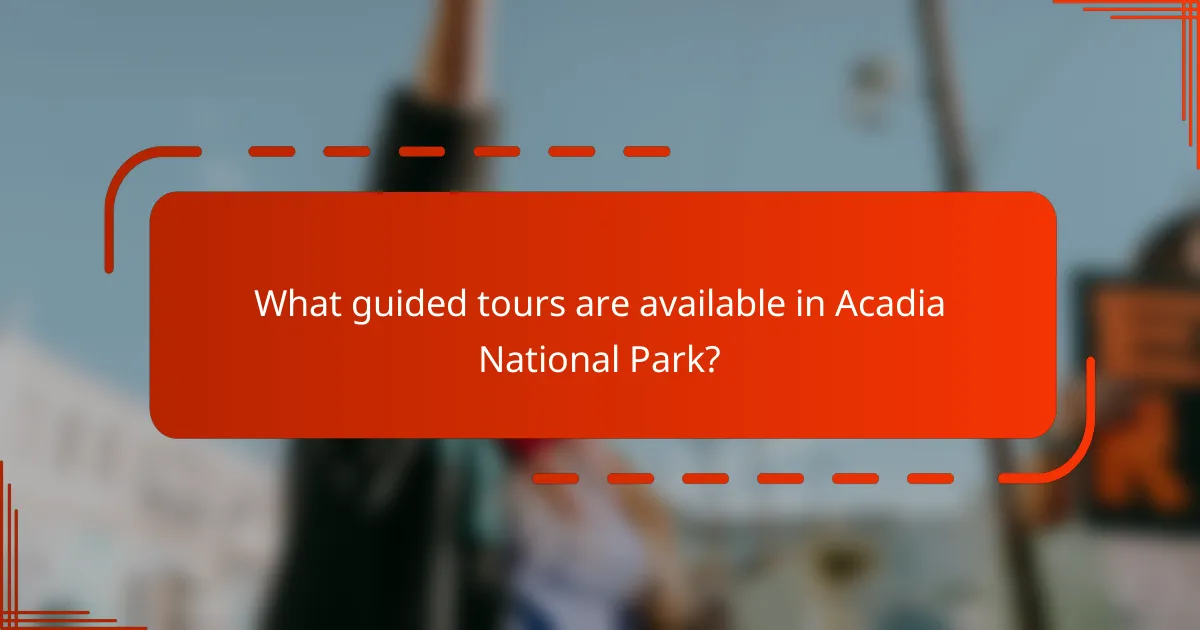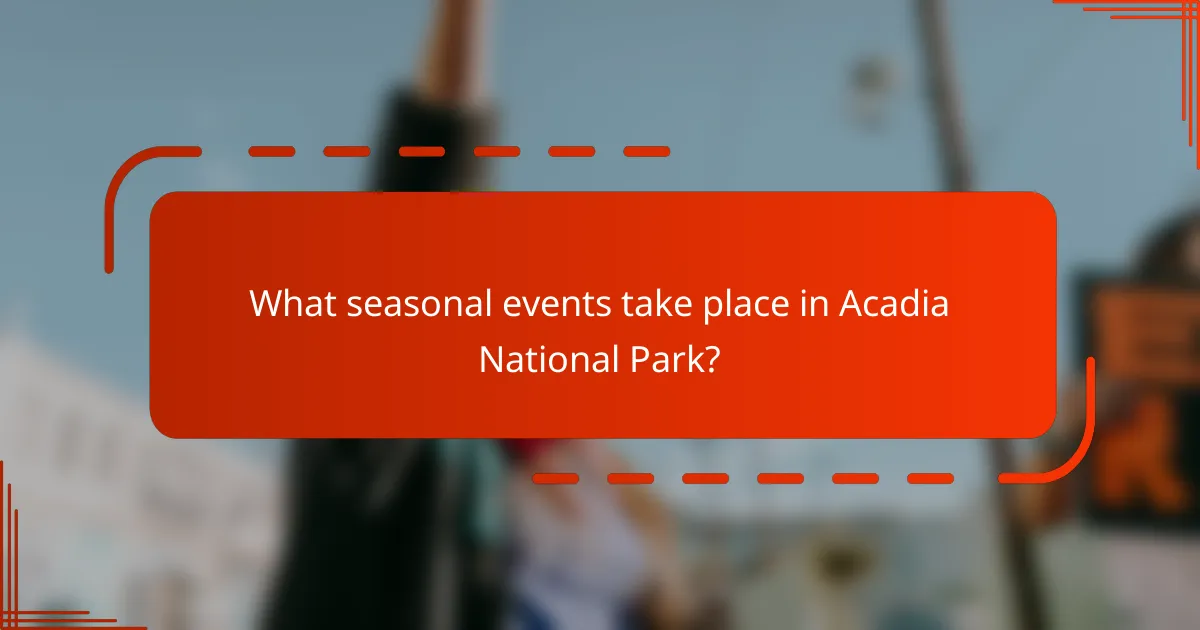Acadia National Park is a protected area on Mount Desert Island in Maine, established in 1916 and covering approximately 49,000 acres of diverse landscapes. The park is renowned for its scenic views, particularly from Cadillac Mountain, and attracts nearly 3 million visitors each year with recreational activities such as hiking, biking, and wildlife watching. Acadia offers guided tours, including ranger-led programs, bike tours, and boat tours that enhance visitor experiences. Seasonal events throughout the year, such as Earth Day clean-ups, nature walks, and the Acadia Night Sky Festival, provide unique opportunities to engage with the park’s natural beauty and cultural heritage.

What is Acadia National Park?
Acadia National Park is a protected area located on Mount Desert Island in Maine. It was established in 1916, making it one of the first national parks in the United States. The park covers approximately 49,000 acres of diverse landscapes, including mountains, forests, and coastlines. Acadia is known for its scenic views, particularly from Cadillac Mountain, which is the highest point on the East Coast. The park attracts nearly 3 million visitors annually, offering numerous recreational activities like hiking, biking, and wildlife watching. Its unique ecosystems support various species, including the endangered peregrine falcon. The park also features historic sites, such as the carriage roads built by John D. Rockefeller Jr.
How was Acadia National Park established?
Acadia National Park was established through a series of land acquisitions and donations. In 1916, the area was designated as Sieur de Monts National Monument. The park was officially designated as Acadia National Park in 1929. Key land donations came from private citizens, including John D. Rockefeller Jr. His contributions helped preserve the park’s unique landscapes. The park encompasses over 49,000 acres of diverse ecosystems. Legislative efforts facilitated its establishment and expansion. Acadia was the first national park east of the Mississippi River. The establishment reflects a commitment to conservation and public enjoyment of natural beauty.
What are the key historical events leading to its creation?
Acadia National Park was established due to a series of key historical events. The area was first inhabited by the Wabanaki people. European settlers arrived in the 17th century, significantly altering the landscape. In the late 19th century, wealthy individuals began to purchase land for summer homes. They recognized the natural beauty of Mount Desert Island. In 1916, the Rockefeller family donated land to the federal government. This led to the creation of a national park. Acadia National Park was officially designated in 1919, becoming the first national park east of the Mississippi River.
What is the significance of Acadia in the context of national parks?
Acadia National Park is significant as it was the first national park established east of the Mississippi River. This designation occurred in 1916, highlighting its importance in the national park system. Acadia showcases diverse ecosystems, including coastal, forest, and alpine environments. It attracts millions of visitors annually, contributing to local economies. The park features unique geological formations, such as Cadillac Mountain, the highest point on the U.S. East Coast. Acadia serves as a model for conservation efforts and sustainable tourism. Its historical and cultural significance is reflected in the presence of Native American heritage and early European settlements. Overall, Acadia National Park exemplifies the value of preserving natural landscapes for future generations.
What are the main features of Acadia National Park?
Acadia National Park features stunning landscapes, diverse ecosystems, and recreational opportunities. The park is known for its granite peaks, particularly Cadillac Mountain, which is the highest point on the East Coast. Acadia offers over 120 miles of hiking trails that cater to various skill levels. The park is home to unique wildlife, including peregrine falcons and black bears. Visitors can enjoy scenic drives, such as the 27-mile Park Loop Road. Additionally, Acadia boasts beautiful coastal views along its rugged shorelines. The park features several campgrounds for overnight stays. Lastly, Acadia is rich in cultural history, with remnants of early Native American and European settlements.
What types of landscapes can be found in Acadia?
Acadia National Park features a diverse range of landscapes. These include rugged coastlines with granite cliffs. The park also has lush forests filled with various tree species. Additionally, there are serene lakes and ponds within the park. Rolling hills and mountains provide stunning views. The park’s terrain includes wetlands and marshes as well. Each landscape type contributes to the park’s ecological diversity. These features make Acadia a unique natural environment for visitors.
How does the biodiversity of Acadia contribute to its ecosystem?
The biodiversity of Acadia contributes significantly to its ecosystem by promoting resilience and stability. This park hosts a variety of species, including over 300 bird species and numerous plant types. Such diversity ensures that ecological roles are filled, from pollination to seed dispersal. It enhances soil health through various root systems and organic matter contributions. Biodiversity also supports food webs, providing habitats for numerous animals. The presence of diverse species helps buffer against environmental changes, like climate fluctuations. Studies show that ecosystems with higher biodiversity are more productive and can recover more effectively from disturbances.
Why is Acadia National Park a popular destination?
Acadia National Park is a popular destination due to its stunning natural beauty and diverse recreational opportunities. The park features breathtaking coastal views, scenic hiking trails, and unique wildlife. Visitors can explore over 120 miles of hiking paths, including the famous Precipice Trail. Acadia’s unique granite peaks, such as Cadillac Mountain, offer panoramic vistas. The park is also home to diverse ecosystems, including forests, wetlands, and ocean habitats. Seasonal activities like leaf-peeping in autumn and snowshoeing in winter attract many tourists. In 2021, Acadia welcomed over 3.5 million visitors, highlighting its popularity. The combination of natural attractions and recreational options makes Acadia National Park a must-visit location.
What unique experiences does Acadia offer to visitors?
Acadia offers unique experiences such as stunning coastal views, diverse wildlife, and outdoor recreational activities. Visitors can explore over 120 miles of hiking trails, including the famous Precipice Trail. Acadia’s scenic drives, like the Park Loop Road, provide breathtaking vistas. The park is home to unique geological features, including Cadillac Mountain, the highest point on the U.S. East Coast. Visitors can also enjoy ranger-led programs that highlight the park’s natural and cultural history. Additionally, Acadia’s dark skies offer exceptional stargazing opportunities. The park’s diverse ecosystems support a variety of species, making it ideal for wildlife observation. These experiences collectively showcase Acadia’s natural beauty and ecological significance.
How does Acadia compare to other national parks in the U.S.?
Acadia National Park is unique among U.S. national parks due to its coastal landscapes and accessibility. It features the highest coastal headlands in the eastern U.S., specifically Cadillac Mountain. Acadia offers a combination of mountains, forests, and ocean views that is rare among national parks. It receives over 3 million visitors annually, ranking it among the most visited national parks. The park’s diverse ecosystems support various wildlife, including seabirds and deer. Acadia also has a rich cultural history, with Native American and European influences evident in its trails and structures. Compared to others, Acadia’s focus on both natural beauty and historical significance sets it apart.

What guided tours are available in Acadia National Park?
Acadia National Park offers several guided tours. These include ranger-led programs, bike tours, and boat tours. Ranger-led programs cover various topics, including wildlife and park history. Bike tours allow visitors to explore the park’s carriage roads. Boat tours provide a unique view of the coastline and wildlife. Additionally, there are photography tours tailored for capturing the park’s scenery. Each tour is designed to enhance the visitor experience and provide in-depth knowledge about the park.
What types of guided tours can visitors choose from?
Visitors to Acadia National Park can choose from several types of guided tours. These include naturalist-led tours, which focus on the park’s ecology and wildlife. Historical tours highlight the cultural and historical significance of the area. Adventure tours offer activities like kayaking or biking. Scenic drives provide a narrated experience of the park’s landscapes. Boat tours allow visitors to explore the coastline from the water. Each tour type caters to different interests and preferences, ensuring a comprehensive experience of the park’s offerings.
How do ranger-led programs enhance the visitor experience?
Ranger-led programs enhance the visitor experience by providing expert knowledge and engaging activities. These programs offer insights into the park’s ecology, history, and cultural significance. Visitors gain a deeper understanding of the natural environment through guided hikes and educational talks. Additionally, ranger-led programs foster a sense of connection to the park. They encourage active participation in conservation efforts. According to the National Park Service, ranger programs improve visitor satisfaction and promote environmental stewardship. Engaging with rangers allows visitors to ask questions and receive personalized information. Overall, these programs enrich the experience and create lasting memories for visitors.
What are the benefits of taking a private tour in Acadia?
Taking a private tour in Acadia offers personalized experiences tailored to individual preferences. Participants can explore unique trails and hidden spots not typically covered in group tours. Private tours allow for flexible scheduling, accommodating specific interests and time constraints. Tour guides can provide in-depth knowledge about the park’s history, ecology, and geography. This personalized attention often enhances the overall experience, leading to deeper engagement with the natural environment. Additionally, private tours can reduce wait times and crowd exposure, making for a more enjoyable visit.
How can visitors book guided tours in Acadia?
Visitors can book guided tours in Acadia through various methods. They can visit official tour company websites to view available options. Many companies offer online booking systems for convenience. Visitors may also call tour operators directly to make reservations. Some tours can be booked at visitor centers within Acadia National Park. Popular guided tours include hiking, biking, and wildlife excursions. Advance booking is recommended, especially during peak seasons. This ensures availability and allows for better planning.
What are the best platforms or resources for making reservations?
The best platforms for making reservations at Acadia National Park include Recreation.gov and the official National Park Service website. Recreation.gov allows users to book campsites and permits online. The National Park Service website provides information on lodging and tour reservations. Both platforms ensure accurate availability and secure transactions. Additionally, popular travel websites like Expedia and Booking.com offer options for nearby accommodations. These resources are widely recognized for their reliability and user-friendly interfaces.
What is the typical cost range for guided tours in Acadia?
The typical cost range for guided tours in Acadia is between $30 to $100 per person. Prices vary based on the type of tour and duration. For example, a half-day tour may cost around $50, while full-day excursions can reach up to $100. Seasonal factors also influence pricing. Peak season often sees higher rates due to increased demand. Additionally, specialized tours, such as photography or wildlife tours, may charge premium prices.
What should visitors expect from a guided tour in Acadia?
Visitors should expect informative and engaging experiences from a guided tour in Acadia. These tours typically cover key attractions such as Cadillac Mountain and Jordan Pond. Guides often share insights about the park’s history, geology, and wildlife. Tours can vary in length, usually lasting from two to four hours. Participants may enjoy scenic views and opportunities for photography. Many tours offer a chance to learn about local flora and fauna. Some tours include hands-on activities like hiking or kayaking. Overall, guided tours provide a structured way to explore Acadia’s natural beauty and rich heritage.
How long do guided tours usually last?
Guided tours usually last between two to four hours. This duration allows for a comprehensive exploration of key sites within Acadia National Park. Many tours are designed to provide in-depth information while ensuring adequate time for questions and interactions. Some specialized tours may extend beyond four hours, depending on the itinerary and specific locations included. Factors like group size and participant engagement can also influence the overall length of the tour.
What essential items should visitors bring on a guided tour?
Visitors on a guided tour should bring essential items such as water, snacks, and a map. Staying hydrated is crucial during outdoor activities. Snacks provide energy for the duration of the tour. A map helps navigate the area and enhances the experience. Additionally, wearing comfortable shoes is important for walking. Sunscreen protects against UV rays, especially in open areas. A camera captures memorable moments. Finally, a light jacket is advisable for changing weather conditions. These items ensure a comfortable and enjoyable guided tour experience.

What seasonal events take place in Acadia National Park?
Acadia National Park hosts various seasonal events throughout the year. In spring, the park celebrates Earth Day with volunteer clean-up events. Summer features ranger-led programs and guided nature walks. Fall brings the popular Acadia Night Sky Festival, highlighting stargazing opportunities. Winter includes activities like snowshoeing and winter hikes, often guided by park rangers. Each season provides unique experiences that connect visitors to the park’s natural beauty and cultural heritage.
What are the major seasonal events held in Acadia?
Acadia National Park hosts several major seasonal events throughout the year. In spring, the park celebrates the opening of the visitor centers and the blooming of wildflowers. Summer features the popular “Acadia Night Sky Festival,” which highlights astronomy and stargazing. Fall brings the “Acadia Harvest Festival,” showcasing local food, crafts, and music. Winter offers activities like the “Acadia Winter Trails Day,” promoting winter sports and outdoor fun. Each event attracts visitors and enhances the park’s community engagement.
How does the park celebrate the changing seasons?
Acadia National Park celebrates the changing seasons through various events and activities. In spring, the park hosts wildflower walks and birdwatching tours. Summer features ranger-led programs and evening concerts. Autumn is marked by foliage tours and harvest festivals. Winter offers snowshoeing and cross-country skiing events. Each season showcases unique natural beauty and recreational opportunities. These celebrations draw visitors and enhance their experience of the park’s diverse ecosystems.
What unique activities are offered during specific seasons?
Acadia National Park offers unique activities during each season. In spring, visitors can enjoy wildflower walks and birdwatching as migratory birds return. Summer provides opportunities for kayaking and ranger-led programs focused on marine life. Fall is renowned for leaf-peeping and guided hikes to experience vibrant foliage. Winter activities include snowshoeing and cross-country skiing on designated trails. Each season showcases the park’s diverse natural beauty and recreational offerings.
How can visitors participate in seasonal events at Acadia?
Visitors can participate in seasonal events at Acadia by attending organized activities such as ranger-led programs, workshops, and community events. These events typically include guided hikes, educational talks, and seasonal celebrations. The park’s website provides a calendar of upcoming events, allowing visitors to plan their participation. Additionally, visitors can join volunteer opportunities during seasonal events to contribute to park conservation efforts. Reservations may be required for some activities, and visitors are encouraged to check for specific details before their visit.
What is the process for registering for events?
The process for registering for events at Acadia National Park typically involves visiting the official park website. Users can find a list of upcoming events and tours on the site. Each event page contains specific registration details. Participants may need to fill out an online form or call a designated number. Some events may require a fee, which can be paid online. It is advisable to register early due to limited availability. Confirmation emails are usually sent upon successful registration. This process ensures that visitors secure their spots for popular events.
What are the best times of year to visit for specific events?
The best times of year to visit Acadia National Park for specific events are late spring, summer, and early fall. Late spring, around May, features the Acadia Spring Festival, showcasing local art and culture. Summer, particularly July and August, hosts numerous outdoor concerts and the popular Bar Harbor Music Festival. Early fall, especially September and October, is ideal for the Acadia’s Fall Foliage Festival, attracting visitors to witness vibrant autumn colors. These events highlight the park’s natural beauty and community spirit, making these seasons particularly appealing for visitors.
What resources are available for staying updated on seasonal events?
Online calendars, social media, and newsletters are key resources for staying updated on seasonal events. Acadia National Park’s official website features an events calendar with details on upcoming activities. Social media platforms like Facebook and Instagram provide real-time updates from the park’s official accounts. Additionally, subscribing to newsletters can deliver event information directly to your inbox. Local tourism websites also list seasonal events and activities in the area. These resources ensure visitors are informed about seasonal happenings within Acadia National Park.
How can visitors access the park’s event calendar?
Visitors can access Acadia National Park’s event calendar through the official park website. The website provides a dedicated section for events, detailing upcoming activities and programs. Users can view dates, times, and descriptions of events. The calendar is regularly updated to reflect new and seasonal offerings. Additionally, visitors may sign up for newsletters to receive event notifications directly in their email. This ensures they stay informed about all park happenings.
What social media channels provide event information for Acadia?
Acadia National Park provides event information through several social media channels. These include Facebook, Instagram, and Twitter. The official National Park Service Facebook page regularly posts updates about events. Instagram features photos and announcements related to seasonal activities. Twitter provides quick updates and alerts regarding park events. Each platform engages with visitors and shares important information.
What tips can enhance a visit to Acadia National Park?
To enhance a visit to Acadia National Park, plan your trip during the shoulder seasons of spring or fall. This timing offers fewer crowds and beautiful scenery. Arrive early to secure parking at popular spots like Cadillac Mountain. Utilize the park’s shuttle system to navigate efficiently without the hassle of driving. Bring layers, as weather can change rapidly, especially at higher elevations. Pack snacks and water to stay energized during hikes. Explore lesser-known trails for a quieter experience, such as the Jordan Pond Path. Finally, take time to enjoy the park’s diverse wildlife and scenic vistas, which are best appreciated at sunrise or sunset.
How can visitors prepare for varying weather conditions in the park?
Visitors can prepare for varying weather conditions in Acadia National Park by checking the forecast before their visit. Weather in the park can change rapidly, so it’s essential to stay informed. Dressing in layers allows for adjustments based on temperature changes throughout the day. Waterproof clothing and sturdy footwear are recommended for potential rain or wet trails. Carrying a backpack with essentials, such as snacks and water, ensures readiness for unexpected weather. Additionally, having a map or GPS device helps navigate in case of sudden weather changes. These preparations enhance safety and enjoyment while exploring the park.
What are the best practices for wildlife viewing in Acadia?
The best practices for wildlife viewing in Acadia include maintaining a safe distance from animals. This ensures both your safety and the animals’ well-being. Observing wildlife during early morning or late afternoon increases the chances of sightings. Staying quiet and minimizing movement helps avoid startling animals. Using binoculars enhances viewing without intruding on their space. Following park regulations regarding wildlife interactions is crucial for conservation. Lastly, educating yourself about local species improves your experience and understanding of their behaviors.
Acadia National Park, established in 1916, is located on Mount Desert Island in Maine and spans approximately 49,000 acres of diverse landscapes. This article covers guided tours available in the park, including ranger-led programs and private tours, as well as seasonal events that highlight the park’s natural beauty and cultural heritage. Additionally, it provides practical visitor tips for enhancing the experience, such as preparation for varying weather conditions and best practices for wildlife viewing. Overall, the article serves as a comprehensive resource for understanding Acadia National Park’s offerings and visitor engagement opportunities.
